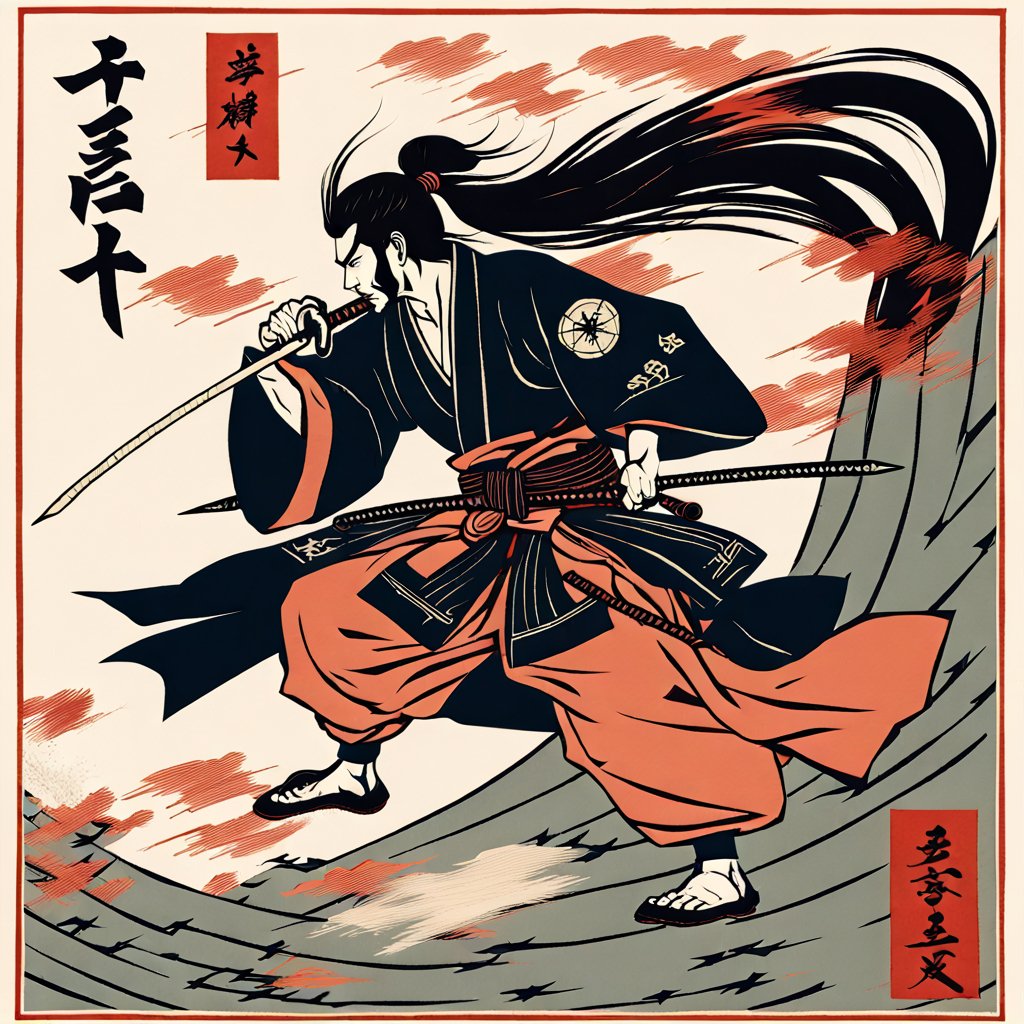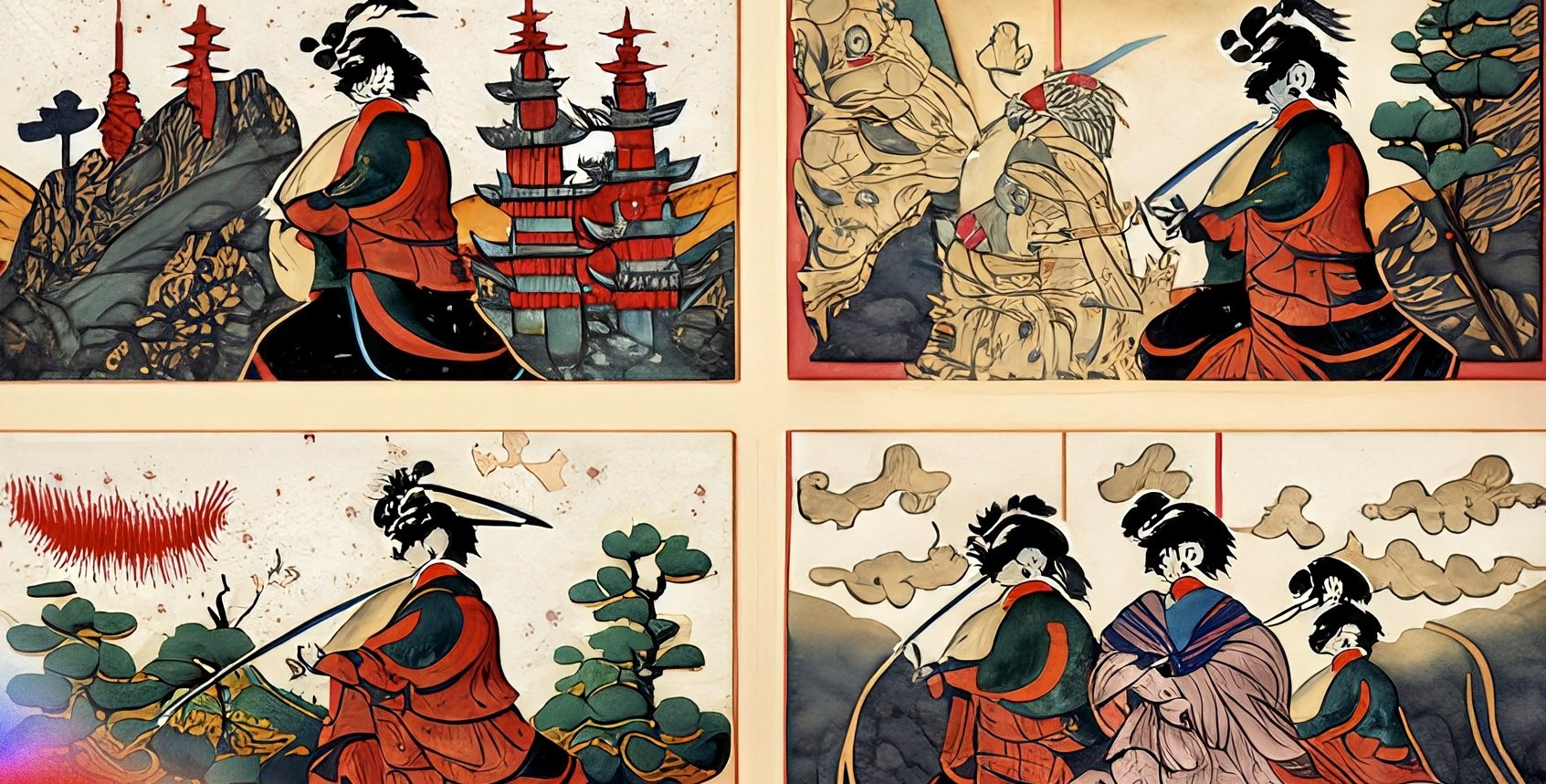Musashi Miyamoto: Legendary Japanse Swordsman
"There is nothing outside of yourself that can ever enable you to get better, stronger, richer, quicker, or smarter. Everything is within. Everything exists inside you."
Across the rolling hills and misty mountains of medieval Japan echoes a name that conjures awe and intrigue - Musashi Miyamoto.
Master swordsman, mystic philosopher, and author of the seminal Book of Five Rings, Musashi exemplified the pinnacle of samurai ideals.
His life interweaves history and mythos into a profound narrative of transformation.
To grasp Musashi’s legacy, we must delve into the tumultuous landscape that cultivated his warrior spirit.
We must trace his journey from blood-forged prodigy to enlightened sage.
For in his evolution we find the essence of Bushido, the Way of the Warrior - japaan unwavering quest for excellence through martial mastery, discipline, and transcendence of the ego.
Come, let us walk the way of the ronin into Musashi’s world to uncover the philosophy and symbolism underlying this epic saga.
1582: Oda Nobunaga assassinated, beginning of Warring States period in Japan marked by intense civil war between warring daimyo warlords
The Forging of a Young Swordsman
On the verdant outskirts of Kumamoto in 1584, Miyamoto Munisai welcomed his son Shinmen Musashi into a Japan fractured by civil war.
As a samurai of the Higo province, Munisai raised Musashi in the austere martial tradition, schooling him in swordsmanship, horsemanship, and military strategy from an early age.
But Musashi’s talents far outpaced his aged father’s.
Seeking greater teachings, the headstrong youth set off alone on musha shugyo - the warrior’s pilgrimage.
Roaming Japan as an independent ronin, Musashi tested his mettle against fighters across the land.
In duels with adepts like the Hozoin spearmaster, Musashi devised innovative techniques later crystallized in his Niten Ichi-ryū style.
Wielding two swords - the lethal katana and nimble wakizashi - in unison, his ability to adapt and control spatial tension was unparalleled.
By 21, Musashi had duelled and defeated many of Japan’s most skilled martial artists.
His combustible mix of talent and aggression was forged in life-and-death struggles into a formidable, if unstable, source of power.
But greater battles loomed ahead.
1584: Musashi born in Miyamoto village of Kumamoto prefecture
Late 1500s: Musashi trains under his father and leaves home as a teenager on musha shugyo (warrior pilgrimage)
Early 1600s: Musashi defeats adepts like Hōzōin Inei and Baiken Sukeemon to begin building his reputation
The Turning Point at Sekigahara
In 1600, tensions between the western and eastern armies of the Tokugawa and Ishida clans erupted at Sekigahara field.
Musashi, now fighting for Lord Ukita, clashed in this pivotal battle. Though Ukita’s forces faced grave defeat, Musashi managed to escape during the mayhem.
The aftermath of Sekigahara marked a drastic shift in Musashi’s journey.
With the Toyotomi loyalists crushed, Musashi renounced servitude to any lord.
Instead, he committed himself entirely to the Way of the Sword as an independent ronin.
Some suggest enlightened monks helped catalyze this transformation, teaching Musashi lessons on mushin, non-attachment, and the sword’s spiritual symbolism.
His style evolved from brute aggression into a fluid, more conscious artistry.
But many opponents still awaited.
As word of the peerless two-sworded samurai spread, duels grew in frequency and legend.
For Musashi, each battle honed both martial skill and inner wisdom.
1600: Musashi fights for the Ukita clan at the Battle of Sekigahara, a major conflict between Tokugawa and Ishida clans
1601: Tokugawa Ieyasu gains control and Musashi abandons allegiance to any clan, focusing solely on his swordsmanship training
"Perceiving the ability of my adversary, I remained constantly alert."
Musashi's Iconic Duels: Gateways to Mastery
Baiken’s Vengeful Rematch
In 1604, Musashi revisited Hozoin temple for a rematch with the spearmaster who had crippled his arm years prior.
When Baiken attacked dishonorably after his defeat, Musashi parried the hidden blade with a mere boat oar - a feat that became etched in history.
The Legendary Duel with Sasaki Kojiro
On Ganryū Island in 1612, Musashi dueled the young prodigy Sasaki Kojiro, renowned for his Chūjō-ryu swordsmanship.
The showdown became legendary when Musashi arrived late wielding a carved bokken he had fashioned from an oar, prompting outrage from onlookers.
But his victory against Kojiro’s razor-sharp nodachi katana neutralized all dissent. Musashi’s cunning and preparation had prevailed.
1604: Musashi defeats Baiken Sukeemon again, parrying his hidden blade with an oar
1610s: Musashi's fame spreads through duels across Japan as he perfects his Niten Ichi-ryū style
1612: Musashi defeats Sasaki Kojirō in their legendary duel at Funajima island
Subduing the Sword-Saint
Even in later years, Musashi was challenged by aspiring swordsmen seeking to make their name known.
One such opponent was the esteemed master Ogasawara who claimed the title “sword-saint”.
But Musashi disarmed him swiftly using his signature two-sword technique, affirming his supremacy as the incontestable master.
Through these and dozens more duels across Japan, Musashi’s skills and reputation soared to mythic heights.
But gradually, a shift emerged in his approach to confrontation and the meaning of victory itself.
From Wanderer to Sage: Musashi's Inner Journey
As a travelling swordsman, Musashi frequented remote temples, conversing with scholarly priests on topics from philosophy to sword technique. Their wisdom regarding mastery as transcendence of self, he realized, paralleled the Way of the Sword.
“Discover each man’s thumbprint. What does he like to do? What is his specialty? Learn his way, based on his abilities. It is foolish to do otherwise and very dangerous."
Chapter 5:Increasingly, Musashi sought isolation - living as a recluse in sacred caves for months of deep meditation, introspection, and study. He began integrating Buddhist, Taoist, and Confucian wisdom into his own evolving code of self-mastery. His Sword became a metaphor for consciously wielding the mind.
1634: Musashi begins three years of deep religious reflection living in Reigandō caves In 1645, sensing his life’s end, Musashi retired to a cave near his childhood home in Kumamoto.
Here he wrote his paradigmatic Go Rin No Sho, or Book of Five Rings, imparting hard-won philosophy on strategy, tactics, discipline, and transcending duality.
Just as his two swords worked in harmony, Musashi synthesized Buddhism's transcendent insight with the immediacy of martial strategy to guide others on the path to mastery.
His life intertwined outer discipline with inner enlightenment in a unified Way.
"When your spirit becomes resolved, progress follows naturally."
1645: Musashi dies from what is believed to be thoracic cancer at age 61
Musashi's Multifaceted Legacy
Philosopher of Mind and Body
Musashi’s Book of Five Rings established him as a profound strategist and philosopher. More than a legendary Japanese swordsman, a philosopher king, and treasure of wisdom.
His teachings on self-mastery, mind-body unity, and adaptability have been applied far beyond swordsmanship into realms from business to self-actualization.
Master of Niten Ichi-ryū
As founder of the two-sword Niten Ichi-ryū style, Musashi shaped the evolution of Japanese swordsmanship.
His innovative style is still taught through koryū, traditional schools descended from samurai lineages.
Musashi's emphasis on adaptability and controlling space continues inspiring students centuries later.
“In strategy your spiritual bearing must not be any different from normal. Both in fighting and in everyday life you should be determined though calm."
Embodiment of Bushido
Musashi's life exemplified the eight virtues of Bushido - the samurai code of honor.
His courage, excellence, loyalty, mastery, benevolence, honesty, restraint, and honor were woven into the fabric of his journey.
Today Musashi endures as the supreme model of the Bushido way.
Cultural Icon
As one of Japan’s most renowned historical figures, Musashi features prominently in literature, manga, anime, video games, and films.
He represents the samurai era's perennial mystique - a humble warrior-philosopher whose disciplined self-transformation conquered all adversaries, inner or outer.
The Eternal Ronin
Musashi's 17th century journey echoes through modern times due to its profound universality - the quest to triumph over ego, master circumstance, and transcend life's illusory dualities by walking in heightened consciousness - what Zen Buddhists call satori.
Like his iconic two swords, Musashi fused the paths of external mastery and inner awareness into a unified Whole reflecting the cosmic Way.
References:
Miyamoto, M., & Harris, V. (2018). The book of five rings. Shambhala Publications.
Tokitsu, K. (2004). Miyamoto Musashi: His life and writings. Shambhala Publications.
Turnbull, S. (2011). Samurai: The world of the warrior. Osprey Publishing.
Wilson, W. S. (2004). The lone samurai: The life of Miyamoto Musashi. Kodansha International.
Yoshikawa, E. (1981). Musashi. Kodansha International.
Through perseverance beyond all obstacles, he actualized the full potential of body, mind and spirit.
Musashi's life story stands not just as a relic of the past, but an eternal reminder that within each of us lies the capacity to follow his footprints towards self-realization and living dynamically through awakened presence, whatever our time and circumstance.
We too can traverse the Warrior's Way, as Musashi - the eternal ronin - remains a guiding light along the eternally unfolding path.
- Mystic Traditions
- Consciousness Research
- Global Wisdom
- The Future is Quantum
- Neuroscience
- Global Mysteries
- Cybersecurity
- Sustainability
- Animal Symbolism
- Spirit Animals Unleashed
- Global Ecology
- Global Creative Culture
- Mayan Riviera
- Shamanism
- Artificial Intelligence
- Holistic Health
- Nature Healing
- Physics
- Extortion Economy
- Creative Healing
- Japan
- Future of Work
- Cyber Defense
- LockBit
- Quantum Interconnectivity
- Non-Human Technologies
- Plant-Based Medicine
- Ransomware
- #BeTheGlitch
- China
- Sacred Geography
- Holographic Universe
- Quantum Computing














































